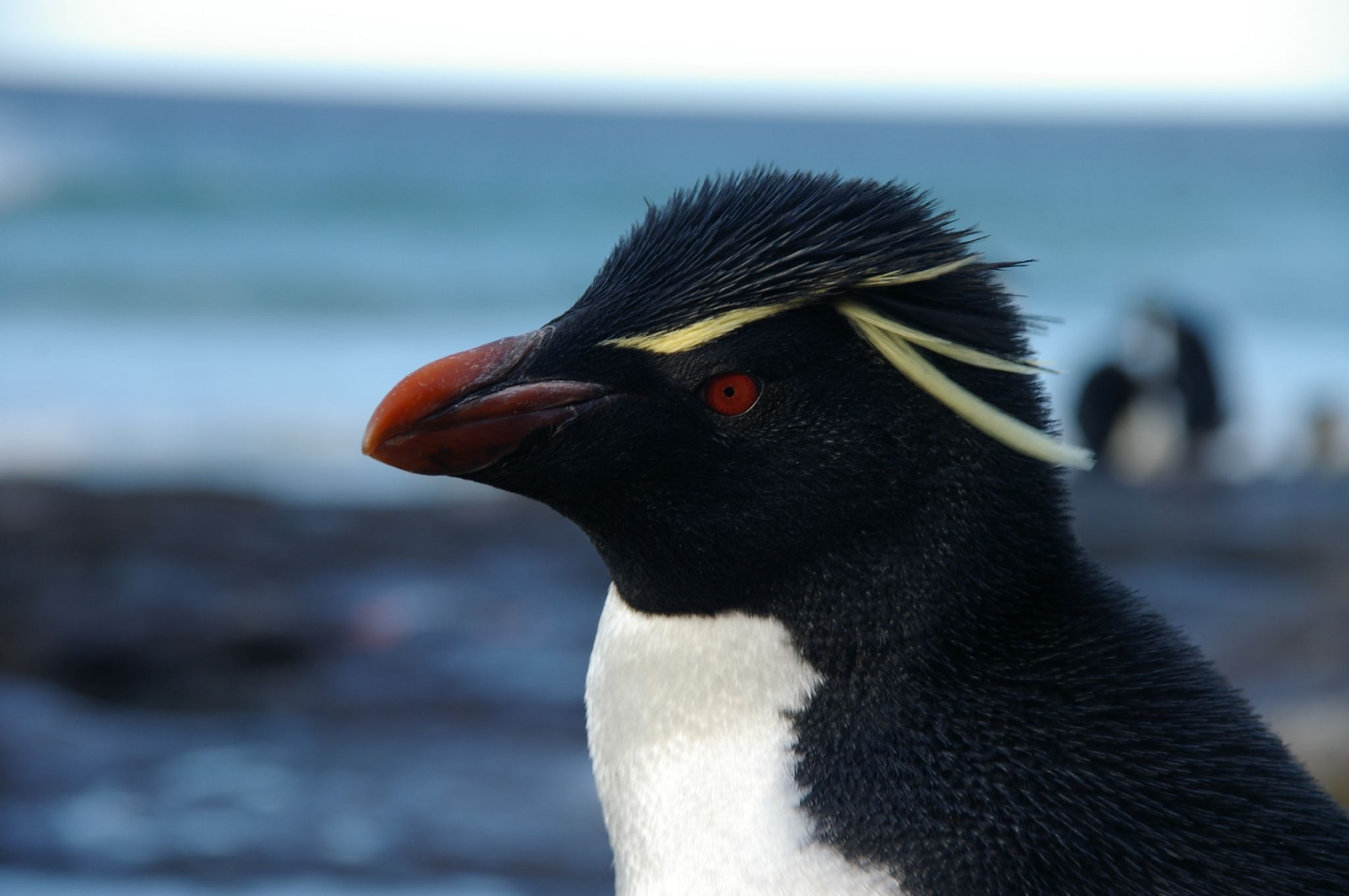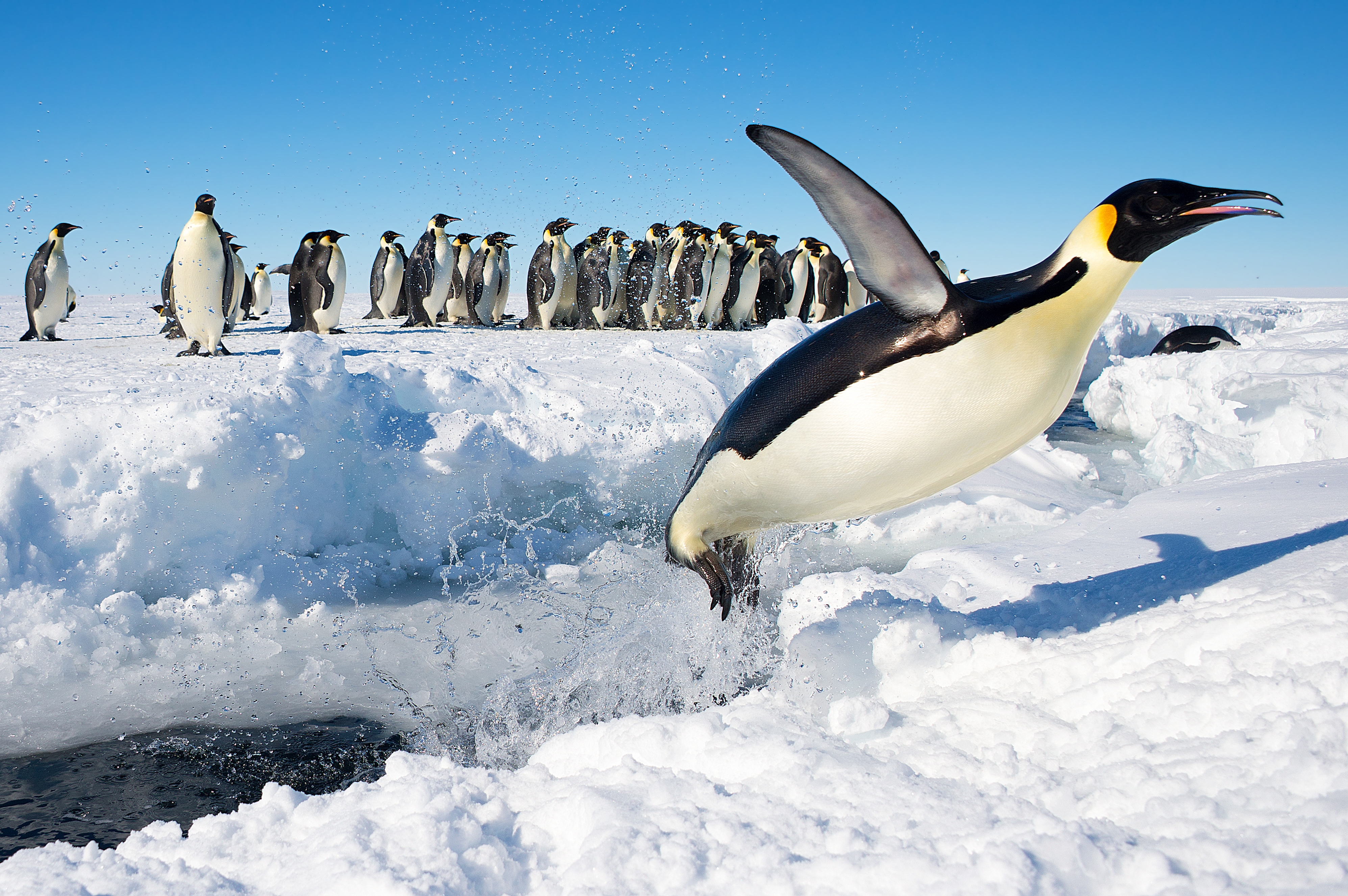|
Sphenisciformes
Penguins are a group of aquatic flightless birds from the family Spheniscidae () of the order Sphenisciformes (). They live almost exclusively in the Southern Hemisphere. Only one species, the Galápagos penguin, is equatorial, with a small portion of its population extending slightly north of the equator (within a quarter degree of latitude). Highly adapted for life in the ocean water, penguins have countershaded dark and white plumage and flippers for swimming. Most penguins feed on krill, fish, squid and other forms of sea life which they catch with their bills and swallow whole while swimming. A penguin has a spiny tongue and powerful jaws to grip slippery prey. They spend about half of their lives on land and the other half in the sea. The largest living species is the emperor penguin (''Aptenodytes forsteri''): on average, adults are about tall and weigh . The smallest penguin species is the little blue penguin (''Eudyptula minor''), also known as the fairy peng ... [...More Info...] [...Related Items...] OR: [Wikipedia] [Google] [Baidu] |
List Of Penguins
Penguin, Penguins are birds in the Family (biology), family Spheniscidae in the Monotypic taxon, monotypic Order (biology), order Sphenisciformes. They inhabit high-productivity marine habitats, almost exclusively in the Southern Hemisphere; the only species to occur north of the Equator is the Galapagos penguin. The only group of birds other than the ratites to be entirely flightless, penguins are extremely adapted to their aquatic lifestyle, with a streamlined shape that minimizes drag, Countershading, countershaded dark-and-white plumage, dense bones, powerful flippers, and insulating feathers that allow them to withstand very low temperatures on land and in water. There are currently 18 extant species of penguins recognised by the International Ornithologists' Union, distributed among six genera. Many species of fossil penguins are known from the Paleocene onwards; however, their exact number and taxonomy are unsettled due to ongoing discoveries. Conventions Conservatio ... [...More Info...] [...Related Items...] OR: [Wikipedia] [Google] [Baidu] |
Flightless Bird
Flightless birds are birds that cannot Bird flight, fly, as they have, through evolution, lost the ability to. There are over 60 extant species, including the well-known ratites (ostriches, emus, cassowary, cassowaries, Rhea (bird), rheas, and Kiwi (bird), kiwis) and penguins. The smallest flightless bird is the Inaccessible Island rail (length 12.5 cm, weight 34.7 g). The largest (both heaviest and tallest) flightless bird, which is also the largest living bird in general, is the common ostrich (2.7 m, 156 kg). Many domesticated birds, such as the domestic chicken and domestic duck, have lost the ability to fly for extended periods, although their ancestral species, the red junglefowl and mallard, respectively, are capable of extended flight. A few particularly bred birds, such as the Broad Breasted White turkey, have become totally flightless as a result of selective breeding; the birds were bred to grow massive breast meat that weighs too much for the bird's wings ... [...More Info...] [...Related Items...] OR: [Wikipedia] [Google] [Baidu] |
Aptenodytes
The genus ''Aptenodytes'' contains two extant species of penguins collectively known as "the great penguins". Etymology The name "Aptenodytes" is a composite of Ancient Greek elements, "ἀ-πτηνο-δύτης" (without-wings-diver). Taxonomy * King penguin, ''Aptenodytes patagonicus'' **''Aptenodytes patagonicus patagonicus'' **''Aptenodytes patagonicus halli'' * Emperor penguin, ''Aptenodytes forsteri'' * Ridgen's penguin (''Aptenodytes ridgeni''), an extinct species known from fossil bones of Early or Late Pliocene The Pliocene ( ; also Pleiocene) is the epoch (geology), epoch in the geologic time scale that extends from 5.33 to 2.58molecular data have shown the genus ''Aptenodytes'' to be basal ... [...More Info...] [...Related Items...] OR: [Wikipedia] [Google] [Baidu] |
Emperor Penguin
The emperor penguin (''Aptenodytes forsteri'') is the tallest and heaviest of all living penguin species and is Endemism in birds, endemic to Antarctica. The male and female are similar in plumage and size, reaching in length and weighing from . Feathers of the head and back are black and sharply delineated from the white belly, pale-yellow breast and bright-yellow ear patches. Like all species of penguin, the emperor is flightless, with a streamlined body, and wings stiffened and flattened into flippers for a marine habitat. Its diet consists primarily of fish, but also includes crustaceans, such as krill, and cephalopods, such as squid. While hunting, the species can remain submerged around 20 minutes, diving to a depth of . It has several adaptations to facilitate this, including an unusually structured Hemoglobin, haemoglobin to allow it to function at low oxygen levels, solid bones to reduce barotrauma, and the ability to reduce its metabolism and shut down non-essential ... [...More Info...] [...Related Items...] OR: [Wikipedia] [Google] [Baidu] |
Eudyptula
The genus ''Eudyptula'' ("good little diver") contains two species of penguin, found in southern Australia, Tasmania, and New Zealand (including the Chatham Islands). They are commonly known as the little penguin, little blue penguin, or, in Australia, fairy penguin. In the language of the Māori people of New Zealand, little penguins are known as . For many years, a white-flippered form of the little penguin found only in North Canterbury, New Zealand was considered either a separate species, '' Eudyptula albosignata'', or just a subspecies, ''Eudyptula minor albosignata''. Analysis of mtDNA revealed that ''Eudyptula'' falls instead into two groups: a western one, found along the southern coast of Australia and the Otago region of New Zealand, and another found in the rest of New Zealand. These two groups are now considered full species: ''Eudyptula novaehollandiae'' in Australia and Otago, and '' Eudyptula minor'' elsewhere. ''E. novaehollandiae'' probably arrived in New Zeal ... [...More Info...] [...Related Items...] OR: [Wikipedia] [Google] [Baidu] |
Water Bird
A water bird, alternatively waterbird or aquatic bird, is a bird that lives on or around water. In some definitions, the term ''water bird'' is especially applied to birds in freshwater ecosystems, although others make no distinction from seabirds that inhabit marine environments. Some water birds (e.g. wading birds) are more terrestrial while others (e.g. waterfowls) are more aquatic, and their adaptations will vary depending on their environment. These adaptations include webbed feet, beaks, and legs adapted to feed in the water, and the ability to dive from the surface or the air to catch prey in water. The term ''aquatic bird'' is sometimes also used in this context. A related term that has a narrower meaning is waterfowl. Some piscivorous birds of prey, such as ospreys, sea eagles, fish eagles, fish owls, and fishing owls, hunt aquatic prey but do not stay in water for long and live predominantly over dry land, and are not considered water birds. The term waterbird ... [...More Info...] [...Related Items...] OR: [Wikipedia] [Google] [Baidu] |
Danian
The Danian is the oldest age or lowest stage of the Paleocene Epoch or Series, of the Paleogene Period or System, and of the Cenozoic Era or Erathem. The beginning of the Danian (and the end of the preceding Maastrichtian) is at the Cretaceous–Paleogene extinction event . The age ended , being followed by the Selandian. Stratigraphic definitions The Danian was introduced in scientific literature by German-Swiss geologist Pierre Jean Édouard Desor in 1847 following a study of fossils found in France and Denmark.Danien Den Store Danske Encyklopædi He identified this stage in deposits from [...More Info...] [...Related Items...] OR: [Wikipedia] [Google] [Baidu] |
Mathurin Jacques Brisson
Mathurin Jacques Brisson (; 30 April 1723 – 23 June 1806) was a French zoologist and natural philosophy, natural philosopher. Brisson was born on 30 April 1723 at Fontenay-le-Comte in the Vendée department of western France. Note that page 141 is before page 140. His parents wished him to take ecclesiastic orders, but in 1747, he abandoned his studies, and from 1749, was employed by the wealthy French naturalist René Antoine Ferchault de Réaumur as the curator of a large private collection of objects related to natural history that de Réaumur kept at his ancestral home at Réaumur, Vendée, Réaumur in the Vendée. Originally published by F. W. Peters in 1951 as ''Die Entwicklung Der Ornithologie von Aristoteles bis zur Gegenwart''. Brisson became interested in the classification of animals and was influenced by the works of Carl Linnaeus and Jacob Theodor Klein. His book ''Le Règne animal'' was published in 1756, and the highly regarded six-volume work ''Ornithologie'' wa ... [...More Info...] [...Related Items...] OR: [Wikipedia] [Google] [Baidu] |
Order (biology)
Order () is one of the eight major hierarchical taxonomic ranks in Linnaean taxonomy. It is classified between family and class. In biological classification, the order is a taxonomic rank used in the classification of organisms and recognized by the nomenclature codes. An immediately higher rank, superorder, is sometimes added directly above order, with suborder directly beneath order. An order can also be defined as a group of related families. What does and does not belong to each order is determined by a taxonomist, as is whether a particular order should be recognized at all. Often there is no exact agreement, with different taxonomists each taking a different position. There are no hard rules that a taxonomist needs to follow in describing or recognizing an order. Some taxa are accepted almost universally, while others are recognized only rarely. The name of an order is usually written with a capital letter. For some groups of organisms, their orders may follow consist ... [...More Info...] [...Related Items...] OR: [Wikipedia] [Google] [Baidu] |
Family (biology)
Family (, : ) is one of the eight major hierarchical taxonomic ranks in Linnaean taxonomy. It is classified between order and genus. A family may be divided into subfamilies, which are intermediate ranks between the ranks of family and genus. The official family names are Latin in origin; however, popular names are often used: for example, walnut trees and hickory trees belong to the family Juglandaceae, but that family is commonly referred to as the "walnut family". The delineation of what constitutes a family—or whether a described family should be acknowledged—is established and decided upon by active taxonomists. There are not strict regulations for outlining or acknowledging a family, yet in the realm of plants, these classifications often rely on both the vegetative and reproductive characteristics of plant species. Taxonomists frequently hold varying perspectives on these descriptions, leading to a lack of widespread consensus within the scientific community ... [...More Info...] [...Related Items...] OR: [Wikipedia] [Google] [Baidu] |
Johann Georg Wagler
Johann Georg Wagler (28 March 1800 – 23 August 1832) was a German herpetologist and ornithologist. Wagler was assistant to Johann Baptist von Spix, and gave lectures in zoology at the Ludwig Maximilian University of Munich after it was moved to Munich. He worked on the extensive collections brought back from Brazil by Spix, and published partly together with him books on reptiles from Brazil. Wagler wrote ''Monographia Psittacorum'' (1832), which included the correct naming of the blue macaws. In 1832, Wagler died of an accidental self-inflicted gunshot wound while out collecting in München-Moosach. Life Johann Georg Wagler was a German naturalist and scientist in the 19th century, whose works primarily focused on herpetology and ornithology (Beolens, Watkins & Grayson, 2011). Johan Georg Wagler was born on 28 March 1800, in the city of Nuremberg, where the Chancellor of the City Court was Wagler's father (Wagler, 1884). After taking up gymnastics at Nuremberg, Johann Georg W ... [...More Info...] [...Related Items...] OR: [Wikipedia] [Google] [Baidu] |





